South Sudan
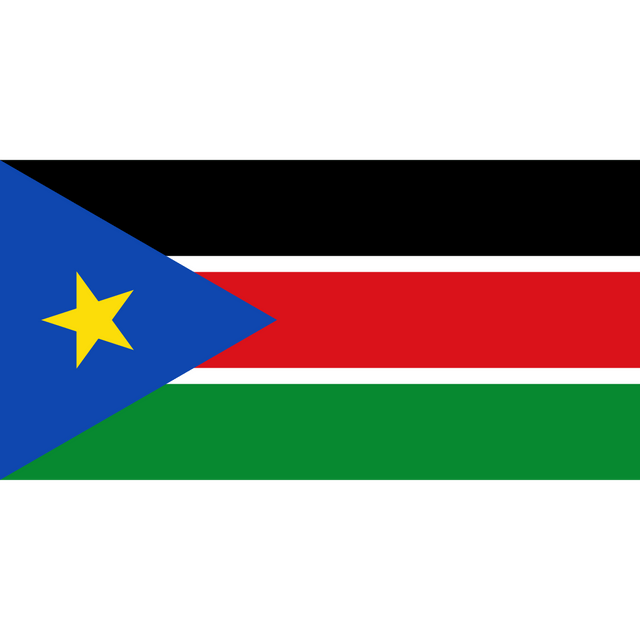
South Sudan

Republic of South Sudan | |
|---|---|
Motto:"Justice, Liberty, Prosperity" | |
Anthem:"South Sudan Oyee!" | |
 Location of South Sudan (dark blue)– in Africa (light blue & dark grey) – in the African Union (light blue) | |
 | |
| Capital and largest city | Juba 04°51′N 31°36′E [254] |
| Official languages | English[3] |
| Recognised national languages |
and around 60 other languages [1] |
| Spoken languages[9] | |
| Demonym(s) | South Sudanese and Nilotic |
| Government | Federal presidential constitutional republic[10] |
• President | Salva Kiir Mayardit |
• Vice President | James Wani Igga |
• First Vice President | Taban Deng Gai |
| Legislature | National Legislature |
• Upper house | Council of States |
• Lower house | National Legislative Assembly |
| Establishment | |
• End of Anglo-Egyptian Sudan | 1 January 1956 |
• Comprehensive Peace Agreement | 6 January 2005 |
• Autonomy | 9 July 2005 |
• Independence from Sudan | 9 July 2011 |
• United Nations admission | 13 July 2011 |
| Area | |
• Total | 619,745 km2(239,285 sq mi) (41st) |
| Population | |
• 2016 estimate | 12,230,730[11] |
• 2008 census | 8,260,490(disputed)[12](94th) |
• Density | 13.33/km2(34.5/sq mi) (214th) |
| GDP(PPP) | 2018 estimate |
• Total | $18.435 billion[13] |
• Per capita | $1,420[13] |
| GDP(nominal) | 2018 estimate |
• Total | $3.194 billion[13] |
• Per capita | $246[13] |
| Gini(2009) | 45.5[14] medium |
| HDI(2017) | low · 187th |
| Currency | South Sudanese pound (SSP) |
| Time zone | UTC+3(East Africa Time) |
| Driving side | right[16] |
| Calling code | +211[17] |
| ISO 3166 code | SS |
| Internet TLD | .ss[18]a |
| |
South Sudan (/suːˈdɑːn, -ˈdæn/ (listen)),[19][20] officially known as the Republic of South Sudan,[21] is a landlocked country in East-Central Africa.[22][23] It gained independence from the Republic of the Sudan in 2011, making it the most recent sovereign state with widespread recognition. Its capital and largest city is Juba.
South Sudan is bordered by Sudan to the north, Ethiopia to the east, Kenya to the southeast, Uganda to the south, the Democratic Republic of the Congo to the southwest and the Central African Republic to the west. It includes the vast swamp region of the Sudd, formed by the White Nile and known locally as the Bahr al Jabal (Arabic: بحر الجبل), meaning "Mountain Sea". Sudan was occupied by Egypt under the Muhammad Ali dynasty and was governed as an Anglo-Egyptian condominium until Sudanese independence in 1956. Following the First Sudanese Civil War, the Southern Sudan Autonomous Region was formed in 1972 and lasted until 1983. A second Sudanese civil war soon broke out, ending in 2005 with the Comprehensive Peace Agreement. Later that year, southern autonomy was restored when an Autonomous Government of Southern Sudan was formed. South Sudan became an independent state on 9 July 2011, following 98.83% support for independence in a January 2011 referendum.[24][25] It has suffered ethnic violence and endured a civil war since 2013.
South Sudan has a population of 12 million, mostly of the Nilotic peoples, and it is demographically among the youngest nations in the world, with roughly half under 18 years old.[26] The majority of inhabitants adhere to Christianity or various traditional faiths. The country is a member of the United Nations,[27][28] the African Union,[29] the East African Community[30] the Intergovernmental Authority on Development.[31] and is a party to the Geneva Conventions.[32] As of 2018, South Sudan ranks third lowest in the latest UN World Happiness Report,[33] second lowest on the Global Peace Index, and has the third highest score on the American Fund for Peace's Fragile States Index.[34]
Republic of South Sudan | |
|---|---|
Motto:"Justice, Liberty, Prosperity" | |
Anthem:"South Sudan Oyee!" | |
 Location of South Sudan (dark blue)– in Africa (light blue & dark grey) – in the African Union (light blue) | |
 | |
| Capital and largest city | Juba 04°51′N 31°36′E [254] |
| Official languages | English[3] |
| Recognised national languages |
and around 60 other languages [1] |
| Spoken languages[9] | |
| Demonym(s) | South Sudanese and Nilotic |
| Government | Federal presidential constitutional republic[10] |
• President | Salva Kiir Mayardit |
• Vice President | James Wani Igga |
• First Vice President | Taban Deng Gai |
| Legislature | National Legislature |
• Upper house | Council of States |
• Lower house | National Legislative Assembly |
| Establishment | |
• End of Anglo-Egyptian Sudan | 1 January 1956 |
• Comprehensive Peace Agreement | 6 January 2005 |
• Autonomy | 9 July 2005 |
• Independence from Sudan | 9 July 2011 |
• United Nations admission | 13 July 2011 |
| Area | |
• Total | 619,745 km2(239,285 sq mi) (41st) |
| Population | |
• 2016 estimate | 12,230,730[11] |
• 2008 census | 8,260,490(disputed)[12](94th) |
• Density | 13.33/km2(34.5/sq mi) (214th) |
| GDP(PPP) | 2018 estimate |
• Total | $18.435 billion[13] |
• Per capita | $1,420[13] |
| GDP(nominal) | 2018 estimate |
• Total | $3.194 billion[13] |
• Per capita | $246[13] |
| Gini(2009) | 45.5[14] medium |
| HDI(2017) | low · 187th |
| Currency | South Sudanese pound (SSP) |
| Time zone | UTC+3(East Africa Time) |
| Driving side | right[16] |
| Calling code | +211[17] |
| ISO 3166 code | SS |
| Internet TLD | .ss[18]a |
| |
History

John Garang de Mabior led the Sudan People's Liberation Army until his death in 2005.
The Nilotic people of South Sudan—the Acholi, Anyuak, Bari, Dinka, Nuer, Shilluk, Kaligi (Arabic Feroghe), and others—first entered South Sudan sometime before the 10th century coinciding with the fall of medieval Nubia. During the period from the 15th to the 19th centuries, tribal migrations, largely from the area of Bahr el Ghazal, brought the Anyuak, Dinka, Nuer and Shilluk to their modern locations of both Bahr El Ghazal and Upper Nile Regions, while the Acholi and Bari settled in Equatoria. The Azande, Mundu, Avukaya and Baka, who entered South Sudan in the 16th century, established the region's largest state of Equatoria Region.
The Dinka are the largest, Nuer the second largest, the Azande the third-largest and the Bari are the fourth-largest ethnic group in the country. They are found in the Maridi, Yambio, and Tombura districts in the tropical rainforest belt of Western Equatoria, the Adio of Azande client in Yei, Central Equatoria and Western Bahr el Ghazal. In the 18th century, the Avungara sib rose to power over the rest of Azande society and this domination continued into the 20th century.[35] Geographical barriers, including the swamplands along the White Nile and the British preference for sending Christian missionaries to the southern regions, including its Closed District Ordinance of 1922 (see History of Anglo-Egyptian Sudan), helped to prevent the spread of Islam to the southerners, thus enabling them to retain their social and cultural heritage, as well as their political and religious institutions. The major reasons include the long history of British policy preference toward developing the Arab north and its ignoring the Black south. After Sudan's first independent elections in 1958, the continued ignoring of the south by Khartoum (lack of schools, roads, bridges) led to uprisings, revolt, and the longest civil war on the continent.[36][37] As of 2012, peoples include Acholi, Anyuak, Azande, Baka, Balanda Bviri, Bari, Boya, Didinga, Dinka, Jiye, Kaligi, Kuku, Lotuka, Mundari, Murie, Nilotic, Nuer, Shilluk, Toposa and Zande.[38]
Slavery had been an institution of Sudanese life throughout history.[39] The slave trade in the south intensified in the 19th century, and continued after the British had suppressed slavery in much of sub-Saharan Africa. Annual Sudanese slave raids into non-Muslim territories resulted in the capture of countless thousands of southern Sudanese, and the destruction of the region's stability and economy.[40]
The Azande have had good relations with the neighbors, namely the Moru, Mundu, Pöjulu, Avukaya, Baka and the small groups in Bahr el Ghazal, due to the expansionist policy of their king Gbudwe, in the 18th century. In the 19th century, the Azande fought the French, the Belgians and the Mahdists to maintain their independence. Egypt, under the rule of Khedive Ismail Pasha, first attempted to control the region in the 1870s, establishing the province of Equatoria in the southern portion. Egypt's first governor was Samuel Baker, commissioned in 1869, followed by Charles George Gordon in 1874 and by Emin Pasha in 1878.[41]
The Mahdist Revolt of the 1880s destabilized the nascent province, and Equatoria ceased to exist as an Egyptian outpost in 1889. Important settlements in Equatoria included Lado, Gondokoro, Dufile and Wadelai. European colonial maneuverings in the region came to a head in 1898, when the Fashoda Incident occurred at present-day Kodok; Britain and France almost went to war over the region.[41] In 1947, British hopes to join South Sudan with Uganda, as well as leaving Western Equatoria as part of the Democratic Republic of the Congo, were dashed by the Rajaf Conference to unify North and South Sudan.
South Sudan has an estimated population of 8 million,[42] but, given the lack of a census in several decades, this estimate may be severely distorted. The economy is predominantly rural and relies chiefly on subsistence farming.[42] Around 2005, the economy began a transition from this rural dominance, and urban areas within South Sudan have seen extensive development.
The region has been negatively affected by two civil wars since Sudanese independence: from 1955 to 1972, the Sudanese government fought the Anyanya rebel army (Anya-Nya is a term in the Madi language which means "snake venom")[43] during the First Sudanese Civil War, followed by the Sudan People's Liberation Army/Movement (SPLA/M) in the Second Sudanese Civil War for over 20 years. As a result, the country suffered serious neglect, a lack of infrastructural development, and major destruction and displacement. More than 2.5 million people have been killed and millions more have become refugees both within and outside the country.
Independence (2011)
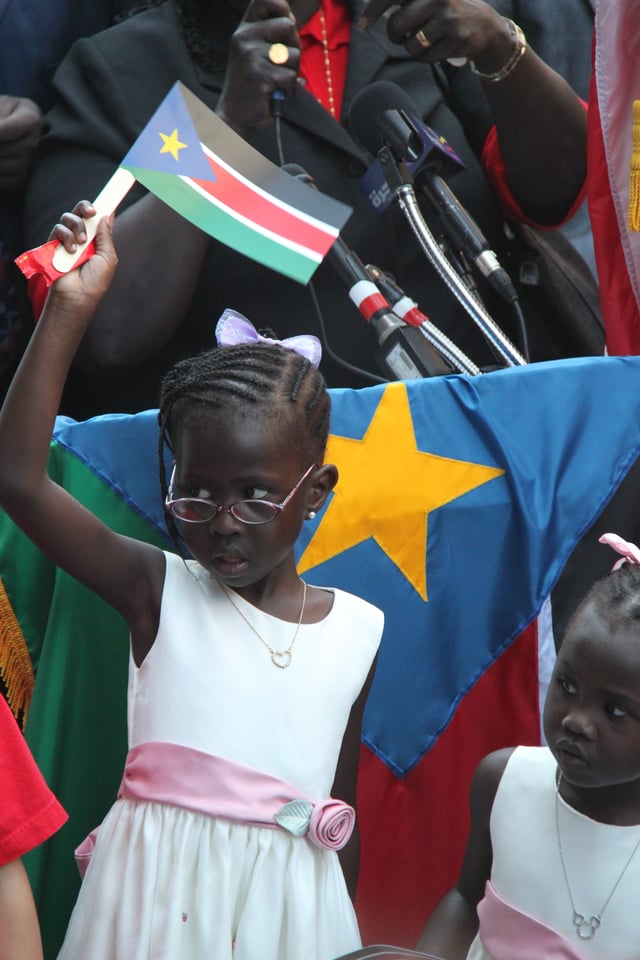
A South Sudanese girl at independence festivities
Between 9 and 15 January 2011, a referendum was held to determine whether South Sudan should become an independent country and separate from Sudan. 98.83% of the population voted for independence.[44] South Sudan formally became independent from Sudan on July 9, although certain disputes still remained, including the division of oil revenues, as 75% of all the former Sudan's oil reserves are in South Sudan.[45] The region of Abyei still remains disputed and a separate referendum will be held in Abyei on whether they want to join Sudan or South Sudan.[46] The South Kordofan conflict broke out in June 2011 between the Army of Sudan and the SPLA over the Nuba Mountains.
On 9 July 2011, South Sudan became the 54th independent country in Africa[47] and since 14 July 2011, South Sudan is the 193rd member of the United Nations.[48] On 27 July 2011, South Sudan became the 54th country to join the African Union.[49]
South Sudan was at war with at least seven armed groups in 9 of its 10 states, with tens of thousands displaced.[50] The fighters accuse the government of plotting to stay in power indefinitely, not fairly representing and supporting all tribal groups while neglecting development in rural areas.[50][51] Joseph Kony's Lord's Resistance Army (LRA) also operates in a wide area that includes South Sudan.[52]
Inter-ethnic warfare that in some cases predates the war of independence is widespread. In December 2011, tribal clashes in Jonglei intensified between the Nuer White Army of the Lou Nuer and the Murle.[53] The White Army warned it would wipe out the Murle and would also fight South Sudanese and UN forces sent to the area around Pibor.[54]
In March 2012, South Sudanese forces seized the Heglig oil fields in lands claimed by both Sudan and South Sudan in the province of South Kordofan after conflict with Sudanese forces in the South Sudanese state of Unity.[55] South Sudan withdrew on March 20, and the Sudanese Army entered Heglig two days later.
Civil war (2013–present)

Military situation in South Sudan as of 1 April 2016 Under control of the Government of South Sudan Under control of the Sudan People's Liberation Movement-in-Opposition Under control of the Government of Sudan
In December 2013, a political power struggle broke out between President Kiir and his former deputy Riek Machar, as the president accused Machar and ten others of attempting a coup d'état.[56] Fighting broke out, igniting the South Sudanese Civil War. Ugandan troops were deployed to fight alongside South Sudanese government forces against the rebels.[57] The United Nations has peacekeepers in the country as part of the United Nations Mission in South Sudan (UNMISS). Numerous ceasefires were mediated by the Intergovernmental Authority on Development (IGAD) between the Sudan People's Liberation Movement (SPLM) and SPLM – in opposition and were subsequently broken. A peace agreement was signed in Ethiopia under threat of United Nations sanctions for both sides in August 2015.[58] Machar returned to Juba in 2016 and was appointed vice president.[59] Following a second breakout of violence in Juba, Machar was replaced as vice-president[60] and he fled the country[61] as the conflict erupted again. Rebel in-fighting has become a major part of the conflict.[62] Rivalry among Dinka factions led by the President and Malong Awan have also led to fighting. In August 2018, another power sharing agreement came into effect.[63]
About 400,000 people are estimated to have been killed in the war,[64] including notable atrocities such as the 2014 Bentiu massacre.[65] Although both men have supporters from across South Sudan's ethnic divides, subsequent fighting has been communal, with rebels targeting members of Kiir's Dinka ethnic group and government soldiers attacking Nuers.[66] More than 4 million people have been displaced, with about 1.8 million of those internally displaced, and about 2.5 million having fled to neighboring countries, especially Uganda and Sudan.[67]
Politics
Government

Salva Kiir Mayardit, the first President of South Sudan. His trademark hat, a Stetson, was a gift from United States President George W. Bush.
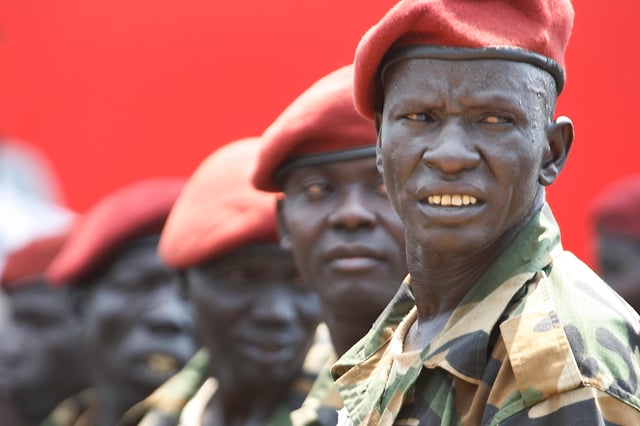
South Sudan's presidential guard on Independence Day, 2011
The now-defunct Southern Sudan Legislative Assembly ratified a transitional constitution[68] shortly before independence on July 9, 2011.[69] The constitution was signed by the President of South Sudan on Independence Day and thereby came into force. It is now the supreme law of the land, superseding the Interim Constitution of 2005.[70]
The constitution establishes a presidential system of government headed by a president who is head of state, head of government, and commander-in-chief of the armed forces. It also establishes the National Legislature comprising two houses: a directly elected assembly, the National Legislative Assembly, and a second chamber of representatives of the states, the Council of States.[71]
John Garang, the founder of the SPLA/M, was the first president of the autonomous government until his death on July 30, 2005. Salva Kiir Mayardit,[21] his deputy, was sworn in as First Vice President of Sudan and President of the Government of Southern Sudan on August 11, 2005. Riek Machar[21] replaced him as Vice-President of the Government. Legislative power is vested in the government and the bicameral National Legislature. The constitution also provides for an independent judiciary, the highest organ being the Supreme Court.
National capital project
The capital of South Sudan is located at Juba, which is also the state capital of Central Equatoria and the county seat of the eponymous Juba County, and is the country's largest city. However, due to Juba's poor infrastructure and massive urban growth, as well as its lack of centrality within South Sudan, the South Sudanese Government adopted a resolution in February 2011 to study the creation of a new planned city to serve as the seat of government.[72][73] It is planned that the capital city will be changed to the more centrally located Ramciel.[74] This proposal is functionally similar to construction projects in Abuja, Nigeria; Brasília, Brazil; and Canberra, Australia; among other modern-era planned national capitals. It is unclear how the government will fund the project.
In September 2011, a spokesman for the government said the country's political leaders had accepted a proposal to build a new capital at Ramciel,[75] a place in Lakes state near the borders with Central Equatoria and Jonglei. Ramciel is considered to be the geographical center of the country,[76] and the late pro-independence leader John Garang allegedly had plans to relocate the capital there before his death in 2005. The proposal was supported by the Lakes state government and at least one Ramciel tribal chief.[77] The design, planning, and construction of the city will likely take as many as five years, government ministers said, and the move of national institutions to the new capital will be implemented in stages.[75]
States
2011–15

The former ten states of South Sudan grouped in the three historical provinces of the Sudan Bahr el Ghazal Equatoria Greater Upper Nile
Prior to 2015, South Sudan was divided into 10 states, which also correspond to three historical regions: Bahr el Ghazal, Equatoria, and Greater Upper Nile:
Northern Bahr el Ghazal
Western Bahr el Ghazal
Lakes
Warrap
Western Equatoria
Central Equatoria (containing the national capital city of Juba)
Eastern Equatoria
Jonglei
Unity
Upper Nile
2017–present
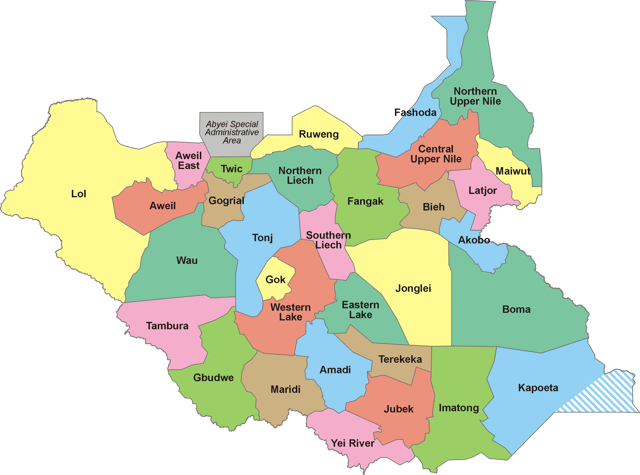
The 32 states of South Sudan, after the addition of 4 more states in 2017
In October 2015, South Sudan's President Salva Kiir issued a decree establishing 28 states in place of the 10 constitutionally established states.[78] The decree established the new states largely along ethnic lines. A number of opposition parties and civil society challenged the constitutionality of this decree and Kiir later resolved to take it to parliament for approval as a constitutional amendment.[79] In November the South Sudanese parliament empowered President Kiir to create new states.[80]
- Bar el Ghazal
Aweil
Aweil East
Eastern Lakes
Gogrial
Gok
Lol
Tonj
Twic
Wau
Western Lakes
- Equatoria
Amadi
Gbudwe
Imatong
Jubek (containing the national capital city of Juba)
Maridi
Kapoeta
Tambura
Terekeka
Yei River
- Greater Upper Nile
Boma
Central Upper Nile
Akobo
Northern Upper Nile
Jonglei
Latjoor
Maiwut
Northern Liech
Ruweng
Southern Liech
Bieh
Fashoda State
Fangak State
The Abyei Area, a small region of Sudan bordering on the South Sudanese states of Northern Bahr el Ghazal, Warrap, and Unity, currently has a special administrative status in Sudan and is governed by an Abyei Area Administration. It was due to hold a referendum in 2011 on whether to join South Sudan or remain part of the Republic of Sudan, but in May the Sudanese military seized Abyei, and it is not clear if the referendum will be held.
Military
As of 2015, South Sudan has the third highest military spending as a percentage of GDP in the world, behind only Oman and Saudi Arabia.[85]
Media
While former Information Minister Barnaba Marial Benjamin vowed that South Sudan will respect freedom of the press and allow journalists unrestricted access in the country, the chief editor of Juba newspaper The Citizen claimed that in the absence of a formal media law in the fledgling republic, he and his staff have faced abuse at the hands of security forces. This alleged fettering of media freedom was attributed in an Al Jazeera report to the difficulty SPLM has faced in reforming itself as a legitimate government after years of leading a rebellion against the Sudanese government. The Citizen is South Sudan's largest newspaper, but poor infrastructure and poverty have kept its staff relatively small and limited the efficiency of both its reporting and its circulation outside of Juba, with no dedicated news bureaus in outlying states and newspapers often taking several days to reach states like Northern Bahr el Ghazal.[86]
Censorship
On November 1, 2011, South Sudan's National Security Services (NSS) arrested the editor of a private Juba-based daily, Destiny, and suspended its activities indefinitely. This was in response to an opinion article by columnist Dengdit Ayok, entitled "Let Me Say So", which criticized the president for allowing his daughter to marry an Ethiopian national, and accused him of "staining his patriotism". An official letter accused the newspaper of breaking "the media code of conduct and professional ethics", and of publishing "illicit news" that was defamatory, inciting, and invading the privacy of personalities. The Committee to Protect Journalists had voiced concerns over media freedoms in South Sudan in September.[87] The NSS released the journalists without charge after having held them for 18 days.[88]
In 2015, Salva Kiir threatened to kill journalists who reported "against the country".[89] Work conditions have become terrible for journalists, and many have left the country. Documentary filmmaker Ochan Hannington is one of them.[90] In August 2015, after journalist Peter Moi was killed in a targeted attack, being the seventh journalist killed during the year, South Sudanese journalists held a 24-hour news blackout.[91]
In August 2017, a 26-year-old American journalist, Christopher Allen, was killed in Kaya, Yei River State, during fighting between government and opposition forces. Christopher Allen was a freelance journalist who had worked for several U.S. news outlets. He had been reportedly embedded with the opposition forces in South Sudan for a week before he was killed.[92] The same month, President Salva Kiir said the millions of civilians fleeing South Sudan were being driven by social media propaganda manned by those conspiring against his government.[93] Just a month prior in July 2017, access to major news websites and popular blogs including Sudan Tribune and Radio Tamujuz had been blocked by the government without formal notice.[94]
Foreign relations
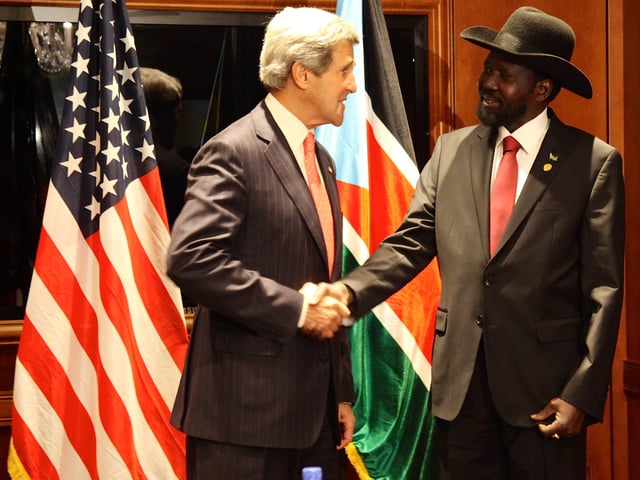
U.S. Secretary of State John Kerry meets with President Salva Kiir, 26 May 2013
Since independence, relations with Sudan have been changing. Sudan's President Omar al-Bashir first announced, in January 2011, that dual citizenship in the North and the South would be allowed,[95] but upon the independence of South Sudan he retracted the offer. He has also suggested an EU-style confederation.[96] Essam Sharaf, Prime Minister of Egypt after the 2011 Egyptian revolution, made his first foreign visit to Khartoum and Juba in the lead-up to South Sudan's secession.[97] Israel quickly recognized South Sudan as an independent country,[98] and is host to thousands of refugees from South Sudan,[99] who now face deportation to their native country.[100][101] According to American sources President Obama officially recognised the new state after Sudan (now North Sudan). Egypt, Sudan, Germany and Kenya were among the first to recognise the country's independence on 8 July 2011.[102][103] Several states that participated in the international negotiations concluded with a self-determination referendum were also quick to acknowledge the overwhelming result. The Rationalist process included Kenya, Uganda, Egypt, Ethiopia, Libya, Eritrea, United Kingdom, and Norway.[104][2]
South Sudan is a member state of the United Nations,[105] the African Union,[29][106] and the Common Market for Eastern and Southern Africa.[107] South Sudan plans to join the Commonwealth of Nations,[108] the East African Community,[109][110][111] the International Monetary Fund,[112] and the World Bank.[113] Some international trade organizations categorize South Sudan as part of the Greater Horn of Africa[114]
Full membership in the Arab League has been assured, should the country's government choose to seek it,[115] though it could also opt for observer status.[116] It was admitted to UNESCO on 3 November 2011.[117] On 25 November 2011, it officially joined the Intergovernmental Authority on Development, a regional grouping of East African states.[118]
The United States supported the 2011 referendum on South Sudan's independence. The New York Times reported that "South Sudan is in many ways an American creation, carved out of war-torn Sudan in a referendum largely orchestrated by the United States, its fragile institutions nurtured with billions of dollars in American aid."[119] The U.S. government's long-standing sanctions against Sudan were officially removed from applicability to newly independent South Sudan in December 2011, and senior RSS officials participated in a high-level international engagement conference in Washington, D.C., to help connect foreign investors with the RSS and South Sudanese private sector representatives.[120] Given the interdependence between some sectors of the economy of the Republic of South Sudan and the Republic of Sudan, certain activities still require OFAC authorization. Absent a license, current Sudanese sanction regulations will continue to prohibit U.S. persons from dealing in property and interests that benefit Sudan or the Government of Sudan.[121] A 2011 Congressional Research Service report, "The Republic of South Sudan: Opportunities and Challenges for Africa’s Newest Country", identifies outstanding political and humanitarian issues as the country forges its future.[122]
Human rights
Campaigns of atrocities against civilians have been attributed to the SPLA.[124] In the SPLA/M's attempt to disarm rebellions among the Shilluk and Murle, they burned scores of villages, raped hundreds of women and girls and killed an untold number of civilians.[125] Civilians alleging torture claim fingernails being torn out, burning plastic bags dripped on children to make their parents hand over weapons, and villagers burned alive in their huts if it was suspected that rebels had spent the night there.[125] In May 2011, the SPLA allegedly set fire to over 7,000 homes in Unity State.[126]
The UN reports many of these violations and the frustrated director of one Juba-based international aid agency calls them "human rights abuses off the Richter scale".[125] In 2010, the CIA issued a warning that "over the next five years,...a new mass killing or genocide is most likely to occur in southern Sudan."[125] The Nuer White Army has stated it wished to "wipe out the entire Murle tribe on the face of the earth as the only solution to guarantee long-term security of Nuer’s cattle"[54] and activists, including Minority Rights Group International, warned of genocide in Jonglei.[127] At the beginning of 2017, genocide was imminent again.[128]
The United Nations rights office has described the situation in the country as "one of the most horrendous human rights situations in the world". It accused the army and allied militias of allowing fighters to rape women as form of payment for fighting, as well as raid cattle in an agreement of "do what you can, take what you can."[135] Amnesty International claimed the army suffocated to death in a shipping container more than 60 people accused of supporting the opposition.[136] On 22 December 2017, at the conclusion of a 12-day visit to the region, the Commission on Human Rights in South Sudan said, "Four years following the start of the current conflict in South Sudan, gross human rights violations continue to be committed in a widespread way by all parties to the conflict, in which civilians are bearing the brunt.[137] The Commission on Human Rights in South Sudan was established by the Human Rights Council in March 2016 [137]
Geography
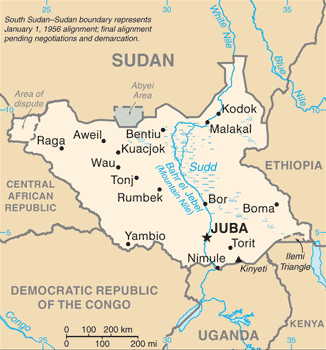
This CIA map uses the provincial borders that existed at the time Sudan gained independence in 1956. In 1960, small sections were transferred to northerly provinces. The Comprehensive Peace Agreement of 2005 ending the second Sudanese civil war provided that the border between southern and northern Sudan would be restored to its 1956 state.
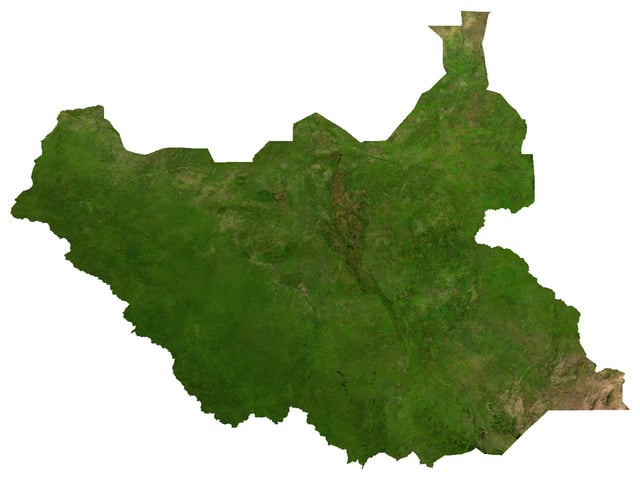
A satellite image of South Sudan
South Sudan lies between latitudes 3° and 13°N, and longitudes 24° and 36°E. It is covered in tropical forest, swamps, and grassland. The White Nile passes through the country, passing by Juba.[95]
Biodiversity
South Sudan's protected area of Bandingilo National Park hosts the second-largest wildlife migration in the world. Surveys have revealed that Boma National Park, west of the Ethiopian border, as well as the Sudd wetland and Southern National Park near the border with Congo, provided habitat for large populations of hartebeest, kob, topi, buffalo, elephants, giraffes, and lions.
South Sudan's forest reserves also provided habitat for bongo, giant forest hogs, red river hogs, forest elephants, chimpanzees, and forest monkeys. Surveys begun in 2005 by WCS in partnership with the semi-autonomous government of Southern Sudan revealed that significant, though diminished wildlife populations still exist, and that, astonishingly, the huge migration of 1.3 million antelopes in the southeast is substantially intact.
Habitats in the country include grasslands, high-altitude plateaus and escarpments, wooded and grassy savannas, floodplains, and wetlands. Associated wildlife species include the endemic white-eared kob and Nile Lechwe, as well as elephants, giraffes, common eland, giant eland, oryx, lions, African wild dogs, cape buffalo, and topi (locally called tiang). Little is known about the white-eared kob and tiang, both types of antelope, whose magnificent migrations were legendary before the civil war. The Boma-Jonglei Landscape region encompasses Boma National Park, broad pasturelands and floodplains, Bandingilo National Park, and the Sudd, a vast area of swamp and seasonally flooded grasslands that includes the Zeraf Wildlife Reserve.
Little is known of the fungi of South Sudan. A list of fungi in Sudan was prepared by S.A.J. Tarr and published by the then Commonwealth Mycological Institute (Kew, Surrey, UK) in 1955. The list, of 383 species in 175 genera, included all fungi observed within the then boundaries of the country. Many of those records relate to what is now South Sudan. Most of the species recorded were associated with diseases of crops. The true number of species of fungi in South Sudan is probably much higher.
In 2006, President Kiir announced that his government would do everything possible to protect and propagate South Sudanese fauna and flora, and seek to reduce the effects of wildfires, waste dumping, and water pollution. The environment is threatened by the development of the economy and infrastructure.
Several ecoregions extend across South Sudan: the East Sudanian savanna, Northern Congolian forest-savanna mosaic, Saharan flooded grasslands (Sudd), Sahelian Acacia savanna, East African montane forests, and the Northern Acacia-Commiphora bushlands and thickets.[138]
Climate

South Sudan map of Köppen climate classification.
South Sudan has a climate similar to an Equatorial or tropical climate, characterized by a rainy season of high humidity and large amounts of rainfall followed by a drier season. The temperature on average is always high with July being the coolest month with an average temperatures falling between 20 and 30 °C (68 and 86 °F) and March being the warmest month with average temperatures ranging from 23 to 37 °C (73 to 98 °F).[139]
The most rainfall is seen between May and October, but the rainy season can commence in April and extend until November. On average May is the wettest month. The season is "influenced by the annual shift of the Inter-Tropical Zone"[21] and the shift to southerly and southwesterly winds leading to slightly lower temperatures, higher humidity, and more cloud coverage.[140]
Demographics
South Sudan has a population of approximately 12 million[11] (UN estimate, the exact figure is disputed) and a predominantly rural, subsistence economy. This region has been negatively affected by war for all but 10 of the years since 1956, resulting in serious neglect, lack of infrastructure development, and major destruction and displacement. More than 2 million people have died, and more than 4 million are internally displaced persons or became refugees as a result of the civil war and its impact.
Urbanization
Ethnic groups
The major ethnic groups present in South Sudan are the Dinka at more than 1 million (approximately 15 percent combined), the Nuer (approximately ten percent), the Bari, and the Azande. The Shilluk constitute a historically influential state along the White Nile, and their language is fairly closely related to Dinka and Nuer. The traditional territories of the Shilluk and the Northeastern Dinka are adjacent.
Education
Unlike the previous educational system of the regional Southern Sudan—which was modelled after the system used in the Republic of Sudan since 1990—the current educational system of the Republic of South Sudan follows the 8 + 4 + 4 system (similar to Kenya). Primary education consists of eight years, followed by four years of secondary education, and then four years of university instruction.
The primary language at all levels is English, as compared to the Republic of Sudan, where the language of instruction is Arabic. In 2007 South Sudan adopted English as the official language of communication. There is a severe shortage of English teachers and English-speaking teachers in the scientific and technical fields.
Languages
There are over 60 indigenous languages, most classified under the Nilo-Saharan Language family; collectively, they represent two of the first-order divisions of Nile Sudanic and Central Sudanic.
Constitution updates
The interim constitution of 2005 declared in Part 1, Chapter 1, No. 6 (1) that "[a]ll indigenous languages of Southern Sudan are national languages and shall be respected, developed and promoted". In Part 1, Chapter 1, No. 6 (2), it was stated: "English and Arabic shall be the official working languages at the level of the governments of Southern Sudan and the States as well as languages of instruction for higher education."[142]
The government of the new independent state later deleted Arabic as an official language and chose English as the sole official language.
The new transitional constitution of the Republic of South Sudan of 2011 declares in Part 1, Chapter 1, No. 6 (1) that "[a]ll indigenous languages of South Sudan are national languages and shall be respected, developed and promoted". In Part 1, Chapter 1, No. 6 (2), it is defined that: "English shall be the official working language in the Republic of South Sudan, as well as the language of instruction at all levels of education."[143]
On July 6, 2017, South Sudan choose to adopt Swahili as an additional official language due to seeking Tanzania's help to send Swahili teachers to the country as it introduces the language in school curriculum ahead of its adoption as an official language.[144]
Some areas
In the border region between Western Bahr el Ghazal state and Sudan are an indeterminate number of people from West African countries who settled here on their way back from Mecca – who have assumed a traditionally nomadic life – that resides either seasonally or permanently. They primarily speak Chadian languages and their traditional territories are in the southern portions of the Sudanese regions of Northern Kurdufan and Darfur.
In the capital, Juba, there are several thousand people who use non-classical Arabic, usually a pidgin called Juba Arabic, but South Sudan's ambassador to Kenya said on 2 August 2011 that Swahili will be introduced in South Sudan with the goal of supplanting Arabic as a lingua franca, in keeping with the country's intention of orientation toward the East African Community rather than Sudan and the Arab League.[145] Nevertheless, South Sudan submitted an application to join the Arab League as a member state on 25 March 2014, which is still pending.[146] In an interview with the newspaper Asharq Al-Awsat, the Foreign Minister of South Sudan Deng Alor Kuol said: South Sudan is the closest African country to the Arab world, and we speak a special kind of Arabic known as Juba Arabic.[147] Sudan supports South Sudan's request to join the Arab League.[148] Juba Arabic is a lingua franca in South Sudan.[149]
Population
2008 census
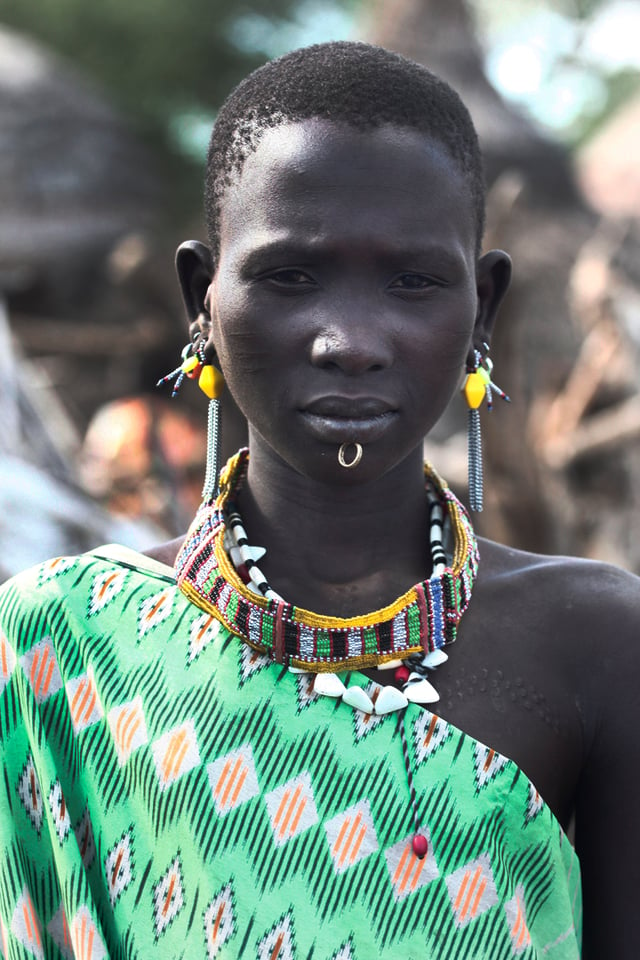
Woman in South Sudan
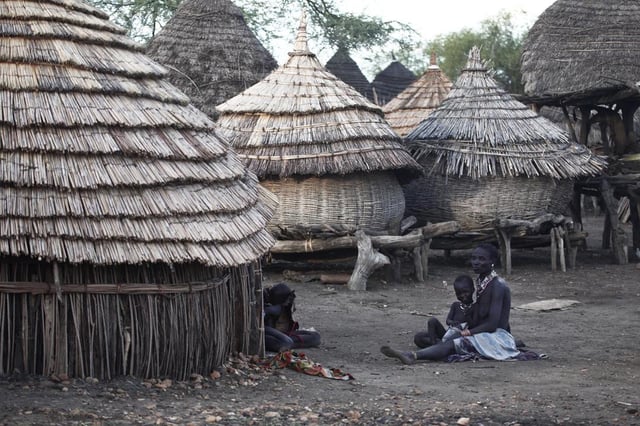
A village in South Sudan
The "Fifth Population and Housing Census of Sudan", for Sudan as a whole, was conducted in April 2008. The census counted the Southern Sudan population at 8.26 million;[12][150] However, Southern Sudanese officials rejected the census results of Southern Sudan because "the central bureau of statistics in Khartoum refused to share the national Sudan raw census data with the southern Sudan centre for census, statistics and evaluation."[151]
In addition, President Kiir "suspected figures were being deflated in some regions and inflated in others, and that made the final tally 'unacceptable'."[152] He claimed that the Southern Sudanese population actually constituted one-third of that of Sudan, though the census showed it to be only 22%.[150]
Many southern Sudanese were also said to have been uncounted "due to bad weather, poor communication and transport networks, and some areas were unreachable, while many southern Sudanese remained in exile in neighbouring countries, leading to 'unacceptable results', according [to] southern Sudanese authorities."[152] The chief American technical adviser for the census in the south said that the census-takers probably reached only 89% of the population.[153]
2009 census
In 2009, Sudan initiated a Southern Sudanese census ahead of the 2011 independence referendum, which would also include the South Sudanese diaspora; however, this initiative was criticised for leaving out countries with a high share of the South Sudanese diaspora, rather counting countries where the diaspora share was low.[154]
Religion
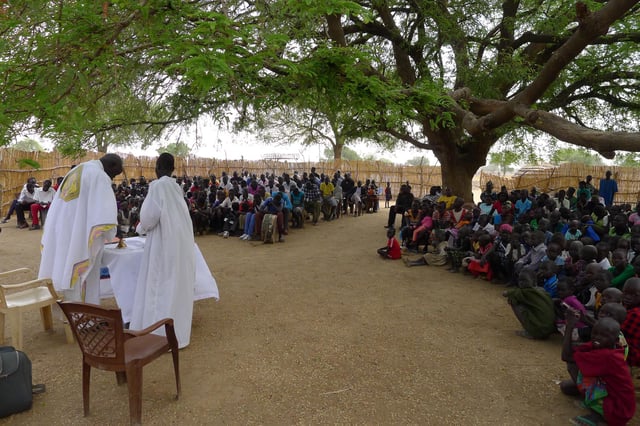
Sunday Mass in the Roman Catholic Diocese of Rumbek
Religions followed by the South Sudanese include traditional indigenous religions, Christianity and Islam.[155][156] The last census to mention the religion of southerners dates back to 1956 where a majority were classified as following traditional beliefs or were Christian while 18% were Muslim.[157] Scholarly[158][159][160] and some U.S. Department of State sources[42] state that a majority of southern Sudanese maintain traditional indigenous (sometimes referred to as animist) beliefs with those following Christianity in a minority. However, according to the U.S. State Department's International Religious Freedom Report of 2012 the majority of the population adhere to Christianity, while reliable statistics on animist and Muslim belief are not available.[161]
The Federal Research Division of the US Library of Congress states that "in the early 1990s possibly no more than 10% of southern Sudan's population was Christian".[162] In the early 1990s, official records of Sudan claimed that the population of what was then included as South Sudan, 25% of people followed traditional religions and 5% were Christians.[163] However, some news reports claim a Christian majority.[164][165]
According to the World Christian Encyclopedia, the Catholic Church is the largest single Christian body in Sudan since 1995, with 2.7 million Catholics mainly concentrated in South Sudan.[166] The US Episcopal Church claims the existence of large numbers of Anglican adherents from the Episcopal Church of the Sudan with 2 million members in 2005.[167] The Presbyterian Church in Sudan is the third largest denomination in Southern Sudan. It has about one million members in 500 congregations in 2012.[168]
A December 18, 2012 report on religion and public life by the Pew Research Center states that in 2010, 60.5% of South Sudan's population was Christian, 32.9% were followers of traditional African religion and 6.2% were Muslim.[169] Some publishers described the conflicts prior to partition as a Muslim-Christian war, but others reject this notion, claiming Muslim and Christian sides sometimes overlapped.[170]
Speaking at Saint Theresa Cathedral in Juba, South Sudanese President Kiir, a Roman Catholic, said that South Sudan would be a nation that respects freedom of religion.[171] Amongst Christians, most are Catholic and Anglican, though other denominations are also active, and animist beliefs are often blended with Christian beliefs.[172]
Diaspora
The South Sudanese diaspora consists of citizens of South Sudan residing abroad. The number of South Sudanese outside South Sudan has sharply increased since the beginning of the struggle for independence from the North Sudan. Almost one and a half million South Sudanese have left the country as refugees, either permanently or as temporary workforce, leading to the establishment of the South Sudanese diaspora population.
The largest communities of the South Sudanese diaspora are located in North America, Western Europe, and Oceania are in the United States, Canada, United Kingdom, Australia, and small communities exist in France, Italy, Germany, Sweden, and New Zealand.
Culture
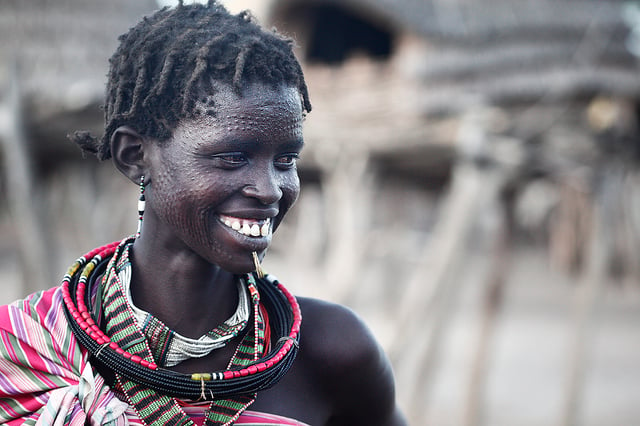
Scarified tribeswoman, South Sudan, 2011
Due to the many years of the civil war, South Sudan's culture is heavily influenced by its neighbours. Many South Sudanese fled to Ethiopia, Kenya and Uganda where they interacted with the nationals and learned their languages and culture. For most of those who remained in the country, or went north to Sudan and Egypt, they largely assimilated Arab culture.
Most South Sudanese value knowing one's tribal origin, its traditional culture and dialect even while in exile and diaspora. Although the common languages spoken are Juba Arabic and English, Swahili is being introduced to the population to improve the country's relations with its East African neighbours.
Music
Many music artists from South Sudan use English, Swahili, Arabi Juba, their dialect or a mix of all. Popular artists like Barbz, Yaba Angelosi sing Afro-beat, R&B, and Zouk; Dynamq is popular for his reggae releases; and Emmanuel Kembe who sings folk, reggae and Afro-beat. Emmanuel Jal is one South Sudanese music artist who has broken through on an international level[173] with his unique form of Hip Hop and a positive message in his lyrics.[174] Jal, a former child soldier turned musician, received good airplay and album reviews in the UK[175] and has also been sought out for the lecture circuit with major talks at popular talkfests like TED.[176]
Games and sports
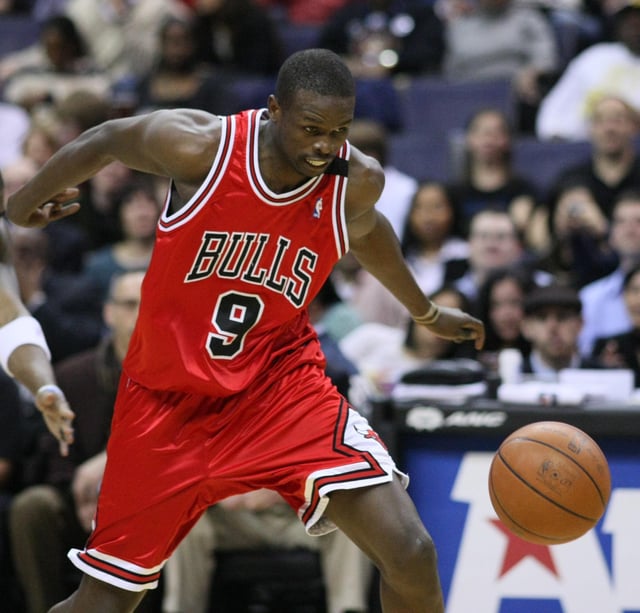
South Sudanese-born basketball player Luol Deng
Many traditional and modern games and sports are popular in South Sudan, particularly wrestling and mock battles. The traditional sports were mainly played after the harvest seasons to celebrate the harvests and finish the farming seasons. During the matches, they smeared themselves with ochre – perhaps to enhance the grip or heighten their perception. The matches attracted large numbers of spectators who sang, played drums and danced in support of their favourite wrestlers. Though these were perceived as competition, they were primarily for entertainment.[177]
Association football is also becoming popular in South Sudan, and there are many initiatives by the Government of South Sudan and other partners to promote the sport and improve the level of play. One of these initiatives is South Sudan Youth Sports Association (SSYSA). SSYSA is already holding football clinics in Konyokonyo and Muniki areas of Juba in which young boys are coached. In recognition of these efforts with youth football, the country recently hosted the CECAFA youth football competitions. Barely a month earlier, it had also hosted the larger East African Schools Sports tournaments.
The South Sudan national association football team joined the Confederation of African Football in February 2012 and became a full FIFA member in May 2012.[178] The team played its first match against Tusker FC of the Kenyan Premier League on 10 July 2011 in Juba as part of independence celebrations,[179] scoring early but losing 1–3 to the more experienced team.[180] Famous South Sudanese footballers are James Moga, Richard Justin, Athir Thomas, Goma Genaro Awad, Khamis Leyano, Khamis Martin and Roy Gulwak.
The South Sudanese can boast links to top basketball players. Luol Deng is a National Basketball Association star in the United States, where he plays for the Minnesota Timberwolves; at the international level, he represents Great Britain. Other leading international basketball players from South Sudan include Manute Bol, Kueth Duany, Deng Gai, Ater Majok, and Thon Maker. The South Sudan national basketball team played its first match against the Uganda national basketball team on 10 July 2011 in Juba.[179]
One athlete from South Sudan, Guor Marial, competed in the 2012 Summer Olympics. Due to South Sudan not as yet possessing an official Olympics organization, and Marial not yet possessing American citizenship, he, along with three athletes from the former Netherlands Antilles, competed under the banner of Independent Olympic Athletes.
On August 2 at the 128th IOC Session, South Sudan was granted full recognition of its National Olympic Committee. South Sudan competed at the 2016 Summer Olympics with three athletes in track and field. No medals were won during this Olympics.[181]
Economy
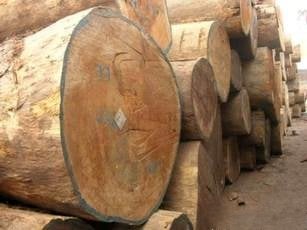
Loka Teaks is the largest teak plantation in Africa.
The economy of South Sudan is one of the world's most underdeveloped with South Sudan having little existing infrastructure and the highest maternal mortality and female illiteracy rates in the world as of 2011.[182] South Sudan exports timber to the international market. The region also contains many natural resources such as petroleum, iron ore, copper, chromium ore, zinc, tungsten, mica, silver, gold, diamonds, hardwoods, limestone and hydropower.[183] The country's economy, as in many other developing countries, is heavily dependent on agriculture.
Other than natural resources-based companies, other such organisations include Southern Sudan Beverages Limited, a subsidiary of SABMiller.
Oil
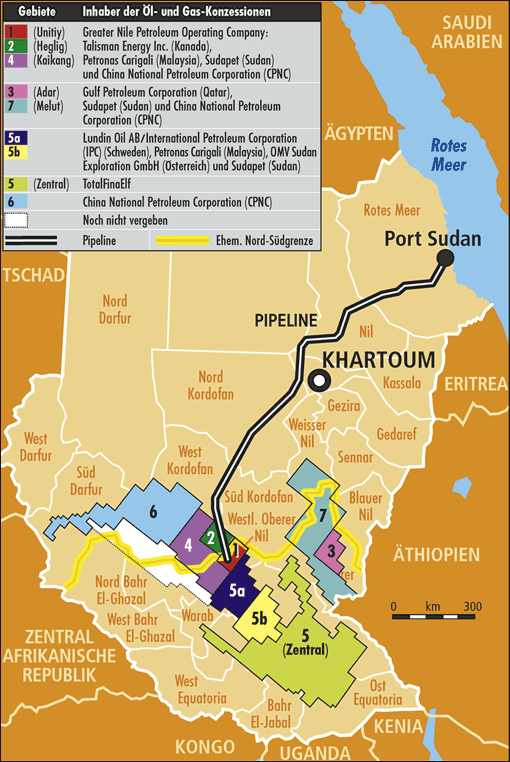
Oil and gas concessions in Sudan – 2004
The oilfields in the south have been significant to the economy since the latter part of the 20th century. South Sudan has the third-largest oil reserves in Sub-Saharan Africa.[184] However, after South Sudan became an independent nation in July 2011, southern and northern negotiators were not immediately able to reach an agreement on how to split the revenue from these southern oilfields.[185]
It is estimated that South Sudan has around 4 times the oil deposits of Sudan. The oil revenues, according to the Comprehensive Peace Agreement (CPA), were split equally for the duration of the agreement period.[186] Since South Sudan relies on pipelines, refineries, and Port Sudan's facilities in Red Sea state in Sudan, the agreement stated that the government of Sudan in Khartoum would receive a 50% share of all oil revenues.[186][187] This arrangement was maintained during the second period of autonomy from 2005 to 2011.
In the run up to independence, northern negotiators reportedly pressed for a deal maintaining the 50–50 split of oil revenues, while the South Sudanese were holding out for more favorable terms.[187] Oil revenues constitute more than 98% of the government of South Sudan's budget according to the southern government's Ministry of Finance and Economic Planning and this has amounted to more than $8 billion in revenue since the signing of the peace agreement.[186]
After independence, South Sudan objected to Sudan charging US$34 per barrel to transport oil through the pipeline to the oil terminal at Port Sudan. With production of around 30,000 barrels per day, this was costing over a million dollars per day. In January 2012, South Sudan suspended oil production, causing a dramatic reduction in revenue and food costs to rise by 120%.[188]
China National Petroleum Corporation (CNPC) is a major investor in South Sudan's oil sector.[184] South Sudan's economy is under pressure to diversify away from oil as oil reserves will likely halve by 2020 if no new finds are made, according to the International Monetary Fund (IMF).[189]
Debt
In terms of South Sudan's external debt, Sudan and South Sudan maintain a shared debt of approximately US$38 billion, all of which has accumulated throughout the past five decades.[190] Though a small portion of this debt is owed to such international institutions as the World Bank and the International Monetary Fund (approximately US$5.3 billion according to a 2009 report provided by the Bank of Sudan), the bulk of its debt load is actually owed to numerous foreign actors that have provided the nation with financial loans, including the Paris Club (over US$11 billion) and also non-Paris Club bilateral creditors (over US$13 billion).[191]
The Paris Club refers to an informal group of financial officials from 19 of the world's most influential economies, including such member nations as the United States, the United Kingdom, Germany, France and Canada, while non-Paris Club bilateral creditors refers to any entity that does not enjoy permanent/associated status as a Paris Club member.[192] Private bilateral creditors (i.e. private commercial banks and private credit suppliers) account for the majority of the remainder (approximately US$6 billion of the total debt).[193]
East African Community
The presidents of Kenya and Rwanda invited the Autonomous Government of Southern Sudan to apply for membership upon the independence of South Sudan in 2011,[109][194] and South Sudan was reportedly an applicant country as of mid-July 2011.[109][195] Analysts suggested that South Sudan's early efforts to integrate infrastructure, including rail links and oil pipelines,[196] with systems in Kenya and Uganda indicated intention on the part of Juba to pivot away from dependence on Sudan and toward the EAC. Reuters considered South Sudan the likeliest candidate for EAC expansion in the short term,[197] and an article in Tanzanian daily The Citizen that reported East African Legislative Assembly Speaker Abdirahin Haithar Abdi said South Sudan was "free to join the EAC" asserted that analysts believe the country will soon become a full member of the regional body.[198]
On 17 September 2011, the Daily Nation quoted a South Sudanese MP as saying that while his government was eager to join the EAC, it would likely delay its membership over concerns that its economy was not sufficiently developed to compete with EAC member states and could become a "dumping ground" for Kenyan, Tanzanian, and Ugandan exports.[199] This was contradicted by President Salva Kiir, who announced South Sudan had officially embarked on the application process one month later.[200] The application was initially deferred by the EAC in December 2012,[201] however incidents with Ugandan boda-boda operators in South Sudan have created political tension and may delay the process.[202]
In December 2012, Tanzania officially agreed to South Sudan's bid to join the EAC, clearing the way for the world's newest state to become the regional bloc's sixth member.[203] In May 2013 The EAC set aside $82,000 for the admission of South Sudan into the bloc even though admission may not happen until 2016. The process, to start after the EAC Council of Ministers meeting in August 2013, was projected to take at least four years. At the 14th Ordinary Summit held in Nairobi in 2012, EAC heads of state approved the verification report that was presented by the Council of Ministers, then directed it to start the negotiation process with South Sudan.[204]
South Sudan's Minister of Foreign Affairs, Barnaba Marial Benjamin, claimed publicly in October 2015 that, following evaluations and meetings of a special technical committee in May, June, August, September and October, the committee has recommended that South Sudan be allowed to join the East African Community. Those recommendations, however, had not been officially released to the public. It was reported that South Sudan could be admitted as early as November 2015 when the heads of East African States had their summit meeting.[207]
South Sudan and the Commonwealth of Nations
South Sudan has applied to join the Commonwealth of Nations,[210] considering that South Sudan was part of the Anglo-Egyptian Sudan, and has 2 Commonwealth republics, Kenya and Uganda as neighbouring countries.
Transport
Railway
South Sudan has 248 km (154 mi) of single-track 3 ft 6 in (1,067 mm) gauge railway line from the Sudanese border to Wau terminus. There are proposed extensions from Wau to Juba. There are also plans to link Juba with the Kenyan and Ugandan railway networks.
Air
The busiest and most developed airport in South Sudan is Juba Airport, which has regular international connections to Asmara, Entebbe, Nairobi, Cairo, Addis Ababa, and Khartoum. Juba Airport was also the home base of Feeder Airlines Company and Southern Star Airlines.[211]
Other international airports include Malakal, with international flights to Addis Ababa and Khartoum; Wau, with weekly service to Khartoum; and Rumbek, also with weekly flights to Khartoum. Southern Sudan Airlines also serves Nimule and Akobo, which have unpaved runways. Several smaller airports exist throughout South Sudan, the majority consisting of little more than dirt runways.
On 4 April 2012, plans were unveiled to launch a South Sudanese national airline, primarily for domestic service at first but eventually expanding to international service.[212]
Humanitarian situation
South Sudan is acknowledged to have some of the worst health indicators in the world.[213][214][215] The under-five infant mortality rate is 135.3 per 1,000, whilst maternal mortality is the highest in the world at 2,053.9 per 100,000 live births.[215] In 2004, there were only three surgeons serving southern Sudan, with three proper hospitals, and in some areas there was just one doctor for every 500,000 people.[213]
The epidemiology of HIV/AIDS in the South Sudan is poorly documented but the prevalence is believed around 3.1%.[216] According to a 2013 study, South Sudan "probably has the highest malaria burden in sub-Saharan Africa".[217] South Sudan is one of the few countries where dracunculiasis still occurs.[218][219][220]
At the time of the Comprehensive Peace Agreement of 2005, humanitarian needs in Southern Sudan were massive. However, humanitarian organizations under the leadership of the UN Office for the Coordination of Humanitarian Affairs (OCHA) managed to ensure sufficient funding to bring relief to the local populations. Along with recovery and development aid, humanitarian projects were included in the 2007 Work Plan of the United Nations and partners. More than 90% of the population of South Sudan live on less than $1 a day, despite the GDP per capita of the entirety of Sudan being $1200 ($3.29/day).[221]
In 2007, the United Nations OCHA (under the leadership of Éliane Duthoit) decreased its involvement in Southern Sudan, as humanitarian needs gradually diminished, slowly but markedly turning over control to the recovery and development activities of NGOs and community-based organisations.[222]
Famine reportedly led to deaths in Northern Bahr el Ghazal and Warrap states in mid-2011, though the state governments of both denied hunger there was severe enough to cause fatalities.[223]
In Pibor County located in the Jonglei State, in December 2011 and January 2012, cattle raids led to border clashes that eventually resulted in widespread ethnic violence, with thousands of deaths and tens of thousands of South Sudanese being displaced, and hundreds of Médecins Sans Frontières staff went missing. The government declared the area a disaster zone and took control from local authorities.[224] South Sudan has a very high rate of child marriage.[225] Violence against women is common in the country, and South Sudan's laws and policies have been criticized as inadequate in offering protection.[226][227]
Water crisis
The water supply in South Sudan is faced with numerous challenges. It is estimated that between 50% and 60% of the population of South Sudan has access to an improved water source, such as a hand pump, a protected well or – for a small minority – piped water supply. Although the White Nile runs through the country, water is scarce during the dry season in areas that are not located on the river.
About half the population does not have access to an improved water source, defined as a protected well, standpipe or a handpump within 1 km. The few existing piped water supply systems are often not well maintained and the water they provide is often not safe to drink. Displaced people returning home put a huge strain on infrastructure, and the government institutions in charge of the sector are weak. Substantial external funding from numerous government agencies and non-governmental organizations is available to improve water supply.
Refugees
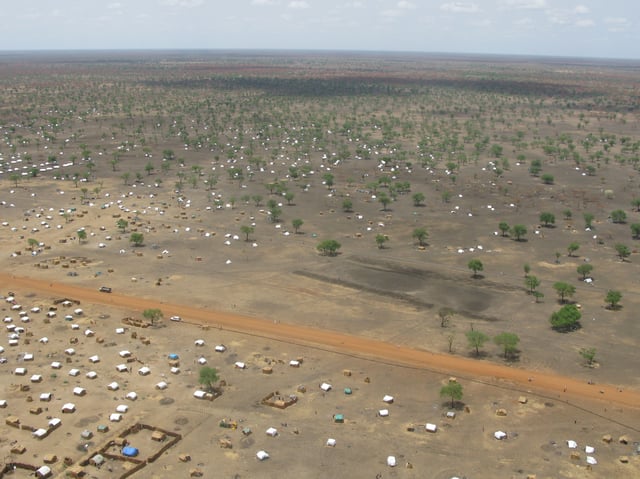
Jamam refugee camp
As of February 2014, South Sudan was host to over 230,000 refugees, with the vast majority, over 209,000, having arrived recently from Sudan, because of the War in Darfur. Other African countries that contribute the most refugees to South Sudan are the Central African Republic, Ethiopia, and the Democratic Republic of the Congo.[230] As a result of the war that erupted in December 2013, more than 2.3 million people – one in every five people in South Sudan – have been forced to flee their homes, including 1.66 million internally displaced people (with 53.4 per cent estimated to be children) and nearly 644,900 refugees in neighbouring countries. Some 185,000 internally displaced people (IDPs) have sought refuge in UN Protection of Civilians (PoC) sites, while around 90 per cent of IDPs are on the run or sheltering outside PoC sites.[231] Consequently, UNHCR is stepping up its response through an inter-agency collaborative approach under the leadership of the Humanitarian Coordinator, and working with the International Organization for Migration (IOM). In early February 2013, UNHCR started distributing relief items outside the UN base in Malakal, South Sudan, which was expected to reach 10,000 people.[230]
2017 famine
On 20 February 2017 South Sudan and the United Nations declared a famine in parts of former Unity State, with the warning that it could spread rapidly without further action. Over 100,000 people were affected. The UN World Food Programme said that 40% of the population of South Sudan, 4.9 million people, need food urgently.[232][233] U.N. officials said that President Salva Kiir Mayardit was blocking food deliveries to some areas.[234] Furthermore, UNICEF warned that more than 1 million children in South Sudan were subjected to malnutrition.[235]
An outbreak of fall armyworm further threatened sorghum and maize production by July 2017.[236]
Notable people
Deng Adel (born 1997), NBA player
Malik Agar, politician
Adut Akech (born 1999), model
Abel Alier (born 1931), politician, writer
Jacob Aligo, politician
Theresa Anyuat Bola, politician
Kenny Athiu (born 1992), professional soccer player (A-League)
Grace Bol (born 1990), model
Manute Bol (1962–2010), NBA player and political activist
Mabior Chol (born 1997), professional Australian Rules Football player
Ajak Deng (born 1989), model
Alephonsion Deng (born c. 1982), writer and speaker
Joseph Deng (born 1998), track and field athlete
John Dau (born 1974), birth name: Dhieu-Deng. One of the Lost Boys of Sudan; human rights activist, President of John Dau Foundation
Luol Deng (born 1985), NBA player
Louis Rizick Dominic, politician
Wenyen Gabriel (born 1997), NBA player
John Garang (1945–2005), politician and revolutionary leader
Margret Hassan (born 1997), sprinter
Emmanuel Jal (born 1980), artist, actor, former child soldier, and political activist
Santino Kenyi (born 1993), middle-distance runner
Joseph Lagu (born 1931), former military chief and founder of Anyanya II
Taban Lo Liyong (born 1939), writer
Anjelina Lohalith (born 1993), track and field athlete
Rose Lokonyen (born 1995), track and field athlete
Lawrence Lual Lual (1940–2011), politician
Thon Maker (born 1997), NBA player
Guor Marial (born 1984), track and field athlete
Salva Kiir Mayardit (born 1951), president of South Sudan
Nhial Deng Nhial, politician
Riek Machar Teny, former vice president and rebel leader
Duckie Thot (born 1995), model
Alek Wek (born 1977), model and designer
Anok Yai (born 1997), model
Kuol Manyang Juuk, Politician
See also
Outline of South Sudan

